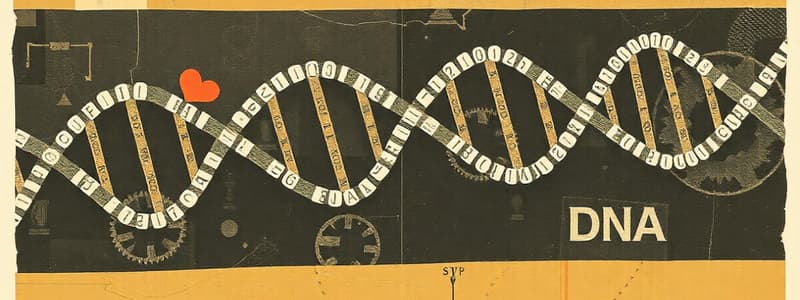Podcast
Questions and Answers
Match the base pairs in DNA:
Match the base pairs in DNA:
Adenine = Thymine Guanine = Cytosine Thymine = Adenine Cytosine = Guanine
Match the DNA components with their functions:
Match the DNA components with their functions:
Nucleotide = Building block of DNA Amino Acid = Building block of proteins Protein = Function determined by amino acid sequence DNA = Template for protein synthesis
Match the effect of a nucleotide change:
Match the effect of a nucleotide change:
G-A-G to G-T-G = Glutamine to Valine C-G-T to C-G-A = Alanine to Arginine A-T-C to A-G-C = Methionine to Serine T-A-G to T-G-G = Tyrosine to Glycine
Match the steps of DNA replication:
Match the steps of DNA replication:
Match the following terms with their descriptions in DNA typing:
Match the following terms with their descriptions in DNA typing:
Match the following processes in DNA analysis with their descriptions:
Match the following processes in DNA analysis with their descriptions:
Match the following types of DNA repeats with their characteristics:
Match the following types of DNA repeats with their characteristics:
Match the following terms with their meanings in the context of RFLP testing:
Match the following terms with their meanings in the context of RFLP testing:
Match the following steps in DNA testing with their order of occurrence:
Match the following steps in DNA testing with their order of occurrence:
Match the following descriptions with their correct terms in DNA typing:
Match the following descriptions with their correct terms in DNA typing:
Match the following types of DNA movement with their characteristics:
Match the following types of DNA movement with their characteristics:
Match the following pairs of terms with their connections in DNA sequencing:
Match the following pairs of terms with their connections in DNA sequencing:
Match the following components of DNA typing with their functions:
Match the following components of DNA typing with their functions:
Match the following components of the DNA analysis process with their functions:
Match the following components of the DNA analysis process with their functions:
Match the following terms related to DNA with their definitions:
Match the following terms related to DNA with their definitions:
Match the following elements of the hybridization process with their roles:
Match the following elements of the hybridization process with their roles:
Match the following descriptions to their relevant terms in forensic DNA analysis:
Match the following descriptions to their relevant terms in forensic DNA analysis:
Match the following steps to their related techniques:
Match the following steps to their related techniques:
Match these phrases with their corresponding concepts in DNA:
Match these phrases with their corresponding concepts in DNA:
Match the following concepts with their significance in DNA fragment analysis:
Match the following concepts with their significance in DNA fragment analysis:
Match the biological evidence packaging methods with their descriptions:
Match the biological evidence packaging methods with their descriptions:
Match the types of DNA specimen collection methods with their descriptions:
Match the types of DNA specimen collection methods with their descriptions:
Match the types of storage conditions for biological evidence with their requirements:
Match the types of storage conditions for biological evidence with their requirements:
Match the biological evidence types with their handling instructions:
Match the biological evidence types with their handling instructions:
Match the problems with packaging biological evidence to their causes:
Match the problems with packaging biological evidence to their causes:
Match the following diseases/disorders with their descriptions:
Match the following diseases/disorders with their descriptions:
Match the following DNA technology terms with their uses:
Match the following DNA technology terms with their uses:
Match the following components of CODIS with their functions:
Match the following components of CODIS with their functions:
Match the evidence handling practices with their requirements:
Match the evidence handling practices with their requirements:
Match the following statements with their relevance to forensic science:
Match the following statements with their relevance to forensic science:
Match the genetic technologies with their specific features:
Match the genetic technologies with their specific features:
Match the following components of DNA evidence with their significance:
Match the following components of DNA evidence with their significance:
Match the technologies with their implications in medicine:
Match the technologies with their implications in medicine:
Flashcards are hidden until you start studying




